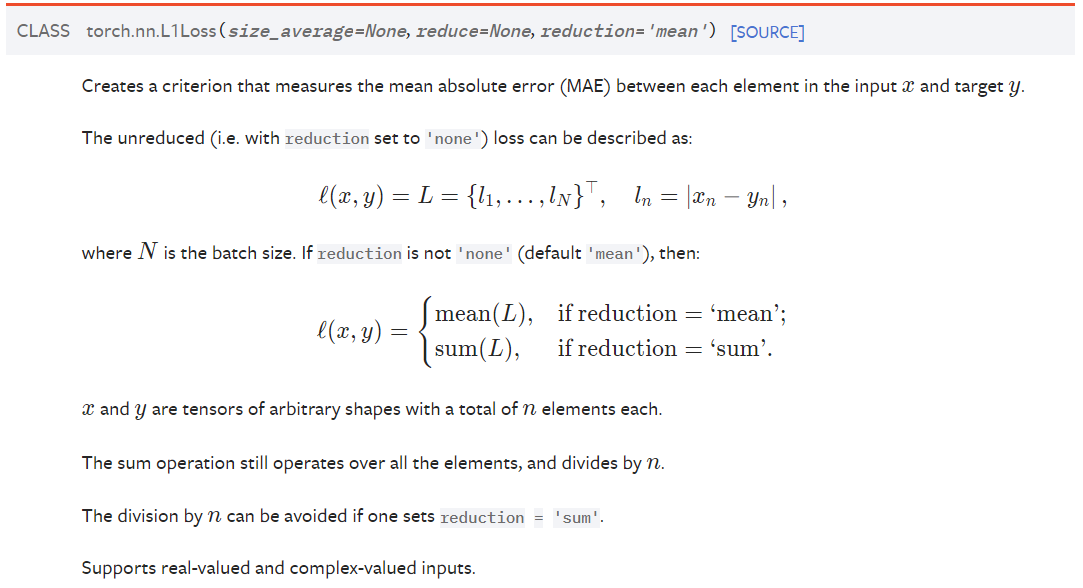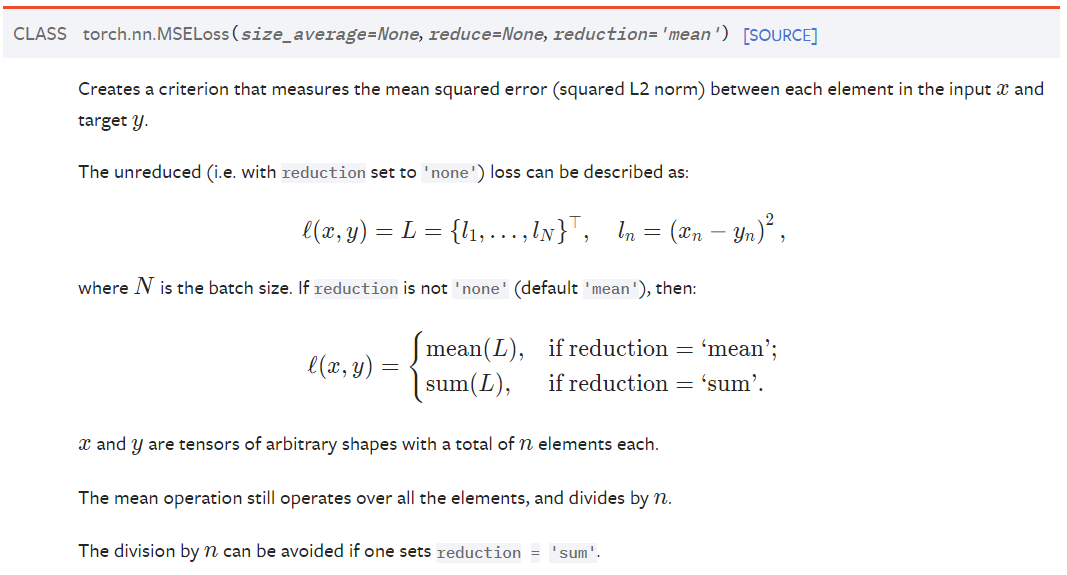我们打开Pytorch官网,找到torch.nn中的loss function,进去如下图所示。

L1LOSS
我们先来看看 L1LOSS 损失函数的使用。下图是官网给出的描述。

L1loss有两种方式,一种是将所有误差累加作为总损失,另一种是将所有误差累加之后求平均作为总损失。
例如,给定输入为input = [1,2,3],期望目标为target = [1,2,5],若L1loss采用累加求和求总损失,那么会有总损失L=|1-1|+|2-2|+|5 -3|=2。如示例2所示。
若L1loss采用累计求和后求平均作为总损失,那么则有总损失L=(|1-1|+|2-2|+|5 -3|)/3=0.6667。如示例1所示。
我们用代码来实现L1loss功能。
示例1:L1loss的方式为累加求和后求平均。
import torch
from torch.nn import L1Loss
inputs = torch.tensor([1, 2, 3], dtype=torch.float32)
targets = torch.tensor([1, 2, 5], dtype=torch.float32)
inputs = torch.reshape(inputs, (1, 1, 1, 3))
targets = torch.reshape(targets, (1, 1, 1, 3))
loss = L1Loss()
result = loss(inputs, targets)
print(result) # tensor(0.6667)
示例2:L1loss的方式为累加求和。 此时L1loss中的参数reduction应为 'sum'。默认为’mean‘。
import torch
from torch.nn import L1Loss
inputs = torch.tensor([1, 2, 3], dtype=torch.float32)
targets = torch.tensor([1, 2, 5], dtype=torch.float32)
inputs = torch.reshape(inputs, (1, 1, 1, 3))
targets = torch.reshape(targets, (1, 1, 1, 3))
loss = L1Loss(reduction='sum')
result = loss(inputs, targets)
print(result) # tensor(2.)
MSELOSS
我们再来看看 MSELOSS 损失函数的使用。下图是官网给出的描述。
MSELOSS 与 L1LOSS唯一的区别是MSELOSS在计算每一项损失时都考虑平方。我们以上面的例子为例。
给定输入为input = [1,2,3],期望目标为target = [1,2,5],若MSEloss采用累加求和求总损失,那么会有总损失L=(1-1)^2+(2-2)^2+(5 -3)^2=4。如示例3所示。
若 MSEloss 采用累计求和后求平均作为总损失,那么则有总损失L = {(1-1)^2+(2-2)^2+(5 -3)^2 } /3=4/3。如示例4所示。
示例3
import torch
from torch.nn import MSELoss
inputs = torch.tensor([1, 2, 3], dtype=torch.float32)
targets = torch.tensor([1, 2, 5], dtype=torch.float32)
inputs = torch.reshape(inputs, (1, 1, 1, 3))
targets = torch.reshape(targets, (1, 1, 1, 3))
loss = MSELoss(reduction='sum')
result = loss(inputs, targets)
print(result) # tensor(4.)
示例4
import torch
from torch.nn import MSELoss
inputs = torch.tensor([1, 2, 3], dtype=torch.float32)
targets = torch.tensor([1, 2, 5], dtype=torch.float32)
inputs = torch.reshape(inputs, (1, 1, 1, 3))
targets = torch.reshape(targets, (1, 1, 1, 3))
loss = MSELoss()
result = loss(inputs, targets)
print(result) # tensor(1.3333)